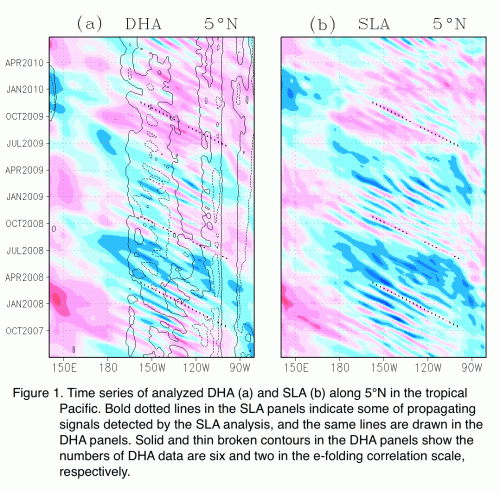Abstract's details
Simple OSE of Argo using space-time scales statistically derived from altimeter data
Event: 2015 Ocean Surface Topography Science Team Meeting
Session: Others (poster only)
Presentation type: Poster
This study shows an application of altimeter data for observing system evaluation (OSE) of the Argo observation network especially for monitoring eddy-scale variation. At first, correlation scale of eddy-scale variations in space-time domain are statistically estimated from along-track sea level anomaly (SLA) data of the 20-year altimetry. Averaged seasonal variations, which sometimes overwhelm eddy signals, and global mean SLA trend are removed a priori from SLA data. Sea surface dynamic height anomalies (DHAs) from mean seasonal variation are derived from Argo temperature and salinity profile data.
DHA fields are obtained by an optimum interpolation (OI) based on the space-time correlation scales estimated from altimeter data. The DHA fields are compared with the SLA fields derived from the same OI applied to the along-track SLA data. The results show that the equatorial Kelvin waves and tropical instability waves are well captured by Argo floats (Figure 1). Eddies are also monitored effectively in the subtropical western North Pacific. The OI results of DHA do not agree well with those of SLA in the high latitudes.
A simple test of the space-time OI analysis shows that more than six data in the e-folding correlation scale, in which the correlation coefficient of ocean variation is above e-1, are required for the reliable analysis with 99% confidence level. Argo floats provide sufficient number of observations for the reliable analysis in the low latitudes and some areas in the North Pacific. Two to three times more Argo data would be required in most of mid-latitudes and much more in high latitudes for capturing eddy-scale variation.
The number of 3,000 Argo floats were considered insufficient to monitor small-scale eddies and rapidly propagating equatorial waves. However, the results show that the Argo floats provide significant information for analysis in the tropical region and for eddy-scale analysis in some other regions. The reason is that the space-time correlation adopted for the OI in this study represent realistic anisotropic feature, e.g. propagation feature of eddy signal, in space-time domain.

DHA fields are obtained by an optimum interpolation (OI) based on the space-time correlation scales estimated from altimeter data. The DHA fields are compared with the SLA fields derived from the same OI applied to the along-track SLA data. The results show that the equatorial Kelvin waves and tropical instability waves are well captured by Argo floats (Figure 1). Eddies are also monitored effectively in the subtropical western North Pacific. The OI results of DHA do not agree well with those of SLA in the high latitudes.
A simple test of the space-time OI analysis shows that more than six data in the e-folding correlation scale, in which the correlation coefficient of ocean variation is above e-1, are required for the reliable analysis with 99% confidence level. Argo floats provide sufficient number of observations for the reliable analysis in the low latitudes and some areas in the North Pacific. Two to three times more Argo data would be required in most of mid-latitudes and much more in high latitudes for capturing eddy-scale variation.
The number of 3,000 Argo floats were considered insufficient to monitor small-scale eddies and rapidly propagating equatorial waves. However, the results show that the Argo floats provide significant information for analysis in the tropical region and for eddy-scale analysis in some other regions. The reason is that the space-time correlation adopted for the OI in this study represent realistic anisotropic feature, e.g. propagation feature of eddy signal, in space-time domain.
Contribution: Kuragano_2015OSTST.pdf (pdf, 4438 ko)
Back to the list of abstract